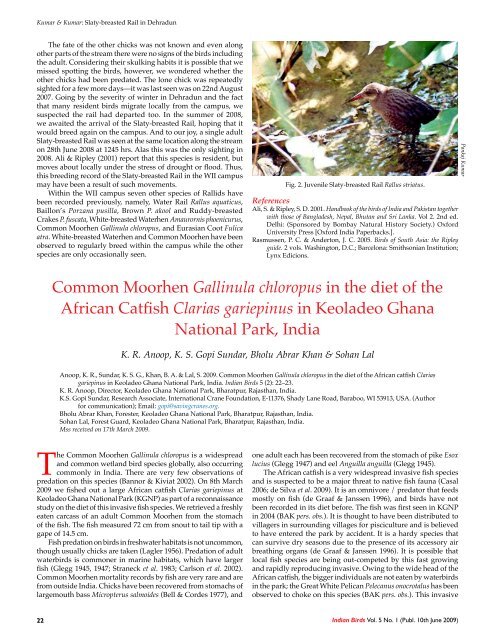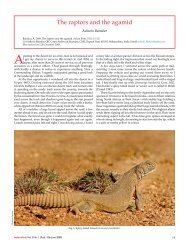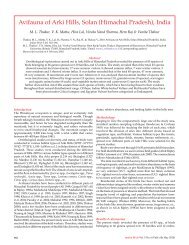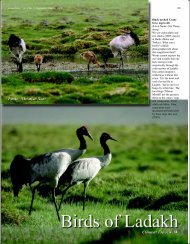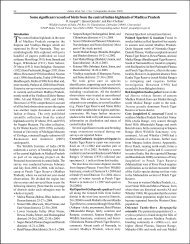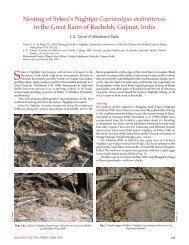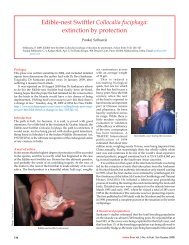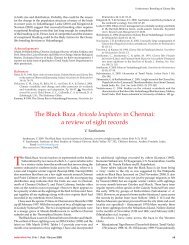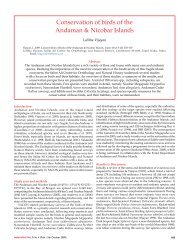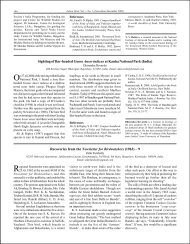Common Moorhen Gallinula chloropus in the diet of ... - Indian Birds
Common Moorhen Gallinula chloropus in the diet of ... - Indian Birds
Common Moorhen Gallinula chloropus in the diet of ... - Indian Birds
You also want an ePaper? Increase the reach of your titles
YUMPU automatically turns print PDFs into web optimized ePapers that Google loves.
Kumar & Kumar: Slaty-breasted Rail <strong>in</strong> Dehradun<br />
The fate <strong>of</strong> <strong>the</strong> o<strong>the</strong>r chicks was not known and even along<br />
o<strong>the</strong>r parts <strong>of</strong> <strong>the</strong> stream <strong>the</strong>re were no signs <strong>of</strong> <strong>the</strong> birds <strong>in</strong>clud<strong>in</strong>g<br />
<strong>the</strong> adult. Consider<strong>in</strong>g <strong>the</strong>ir skulk<strong>in</strong>g habits it is possible that we<br />
missed spott<strong>in</strong>g <strong>the</strong> birds, however, we wondered whe<strong>the</strong>r <strong>the</strong><br />
o<strong>the</strong>r chicks had been predated. The lone chick was repeatedly<br />
sighted for a few more days—it was last seen was on 22nd August<br />
2007. Go<strong>in</strong>g by <strong>the</strong> severity <strong>of</strong> w<strong>in</strong>ter <strong>in</strong> Dehradun and <strong>the</strong> fact<br />
that many resident birds migrate locally from <strong>the</strong> campus, we<br />
suspected <strong>the</strong> rail had departed too. In <strong>the</strong> summer <strong>of</strong> 2008,<br />
we awaited <strong>the</strong> arrival <strong>of</strong> <strong>the</strong> Slaty-breasted Rail, hop<strong>in</strong>g that it<br />
would breed aga<strong>in</strong> on <strong>the</strong> campus. And to our joy, a s<strong>in</strong>gle adult<br />
Slaty-breasted Rail was seen at <strong>the</strong> same location along <strong>the</strong> stream<br />
on 28th June 2008 at 1245 hrs. Alas this was <strong>the</strong> only sight<strong>in</strong>g <strong>in</strong><br />
2008. Ali & Ripley (2001) report that this species is resident, but<br />
moves about locally under <strong>the</strong> stress <strong>of</strong> drought or flood. Thus,<br />
this breed<strong>in</strong>g record <strong>of</strong> <strong>the</strong> Slaty-breasted Rail <strong>in</strong> <strong>the</strong> WII campus<br />
may have been a result <strong>of</strong> such movements.<br />
With<strong>in</strong> <strong>the</strong> WII campus seven o<strong>the</strong>r species <strong>of</strong> Rallids have<br />
been recorded previously, namely, Water Rail Rallus aquaticus,<br />
Baillon’s Porzana pusilla, Brown P. akool and Ruddy-breasted<br />
Crakes P. fuscata, White-breasted Waterhen Amaurornis phoenicurus,<br />
<strong>Common</strong> <strong>Moorhen</strong> <strong>Gall<strong>in</strong>ula</strong> <strong>chloropus</strong>, and Eurasian Coot Fulica<br />
atra. White-breasted Waterhen and <strong>Common</strong> <strong>Moorhen</strong> have been<br />
observed to regularly breed with<strong>in</strong> <strong>the</strong> campus while <strong>the</strong> o<strong>the</strong>r<br />
species are only occasionally seen.<br />
Fig. 2. Juvenile Slaty-breasted Rail Rallus striatus.<br />
References<br />
Ali, S. & Ripley, S. D. 2001. Handbook <strong>of</strong> <strong>the</strong> birds <strong>of</strong> India and Pakistan toge<strong>the</strong>r<br />
with those <strong>of</strong> Bangladesh, Nepal, Bhutan and Sri Lanka. Vol 2. 2nd ed.<br />
Delhi: (Sponsored by Bombay Natural History Society.) Oxford<br />
University Press [Oxford India Paperbacks.].<br />
Rasmussen, P. C. & Anderton, J. C. 2005. <strong>Birds</strong> <strong>of</strong> South Asia: <strong>the</strong> Ripley<br />
guide. 2 vols. Wash<strong>in</strong>gton, D.C.; Barcelona: Smithsonian Institution;<br />
Lynx Edicions.<br />
Pankaj Kumar<br />
<strong>Common</strong> <strong>Moorhen</strong> <strong>Gall<strong>in</strong>ula</strong> <strong>chloropus</strong> <strong>in</strong> <strong>the</strong> <strong>diet</strong> <strong>of</strong> <strong>the</strong><br />
African Catfish Clarias gariep<strong>in</strong>us <strong>in</strong> Keoladeo Ghana<br />
National Park, India<br />
K. R. Anoop, K. S. Gopi Sundar, Bholu Abrar Khan & Sohan Lal<br />
Anoop, K. R., Sundar, K. S. G., Khan, B. A. & Lal, S. 2009. <strong>Common</strong> <strong>Moorhen</strong> <strong>Gall<strong>in</strong>ula</strong> <strong>chloropus</strong> <strong>in</strong> <strong>the</strong> <strong>diet</strong> <strong>of</strong> <strong>the</strong> African catfish Clarias<br />
gariep<strong>in</strong>us <strong>in</strong> Keoladeo Ghana National Park, India. <strong>Indian</strong> <strong>Birds</strong> 5 (2): 22–23.<br />
K. R. Anoop, Director, Keoladeo Ghana National Park, Bharatpur, Rajasthan, India.<br />
K.S. Gopi Sundar, Research Associate, International Crane Foundation, E-11376, Shady Lane Road, Baraboo, WI 53913, USA. (Author<br />
for communication); Email: gopi@sav<strong>in</strong>gcranes.org.<br />
Bholu Abrar Khan, Forester, Keoladeo Ghana National Park, Bharatpur, Rajasthan, India.<br />
Sohan Lal, Forest Guard, Keoladeo Ghana National Park, Bharatpur, Rajasthan, India.<br />
Mss received on 17th March 2009.<br />
The <strong>Common</strong> <strong>Moorhen</strong> <strong>Gall<strong>in</strong>ula</strong> <strong>chloropus</strong> is a widespread<br />
and common wetland bird species globally, also occurr<strong>in</strong>g<br />
commonly <strong>in</strong> India. There are very few observations <strong>of</strong><br />
predation on this species (Bannor & Kiviat 2002). On 8th March<br />
2009 we fished out a large African catfish Clarias gariep<strong>in</strong>us at<br />
Keoladeo Ghana National Park (KGNP) as part <strong>of</strong> a reconnaissance<br />
study on <strong>the</strong> <strong>diet</strong> <strong>of</strong> this <strong>in</strong>vasive fish species. We retrieved a freshly<br />
eaten carcass <strong>of</strong> an adult <strong>Common</strong> <strong>Moorhen</strong> from <strong>the</strong> stomach<br />
<strong>of</strong> <strong>the</strong> fish. The fish measured 72 cm from snout to tail tip with a<br />
gape <strong>of</strong> 14.5 cm.<br />
Fish predation on birds <strong>in</strong> freshwater habitats is not uncommon,<br />
though usually chicks are taken (Lagler 1956). Predation <strong>of</strong> adult<br />
waterbirds is commoner <strong>in</strong> mar<strong>in</strong>e habitats, which have larger<br />
fish (Glegg 1945, 1947; Straneck et al. 1983; Carlson et al. 2002).<br />
<strong>Common</strong> <strong>Moorhen</strong> mortality records by fish are very rare and are<br />
from outside India. Chicks have been recovered from stomachs <strong>of</strong><br />
largemouth bass Micropterus salmoides (Bell & Cordes 1977), and<br />
one adult each has been recovered from <strong>the</strong> stomach <strong>of</strong> pike Esox<br />
lucius (Glegg 1947) and eel Anguilla anguilla (Glegg 1945).<br />
The African catfish is a very widespread <strong>in</strong>vasive fish species<br />
and is suspected to be a major threat to native fish fauna (Casal<br />
2006; de Silva et al. 2009). It is an omnivore / predator that feeds<br />
mostly on fish (de Graaf & Janssen 1996), and birds have not<br />
been recorded <strong>in</strong> its <strong>diet</strong> before. The fish was first seen <strong>in</strong> KGNP<br />
<strong>in</strong> 2004 (BAK pers. obs.). It is thought to have been distributed to<br />
villagers <strong>in</strong> surround<strong>in</strong>g villages for pisciculture and is believed<br />
to have entered <strong>the</strong> park by accident. It is a hardy species that<br />
can survive dry seasons due to <strong>the</strong> presence <strong>of</strong> its accessory air<br />
breath<strong>in</strong>g organs (de Graaf & Janssen 1996). It is possible that<br />
local fish species are be<strong>in</strong>g out-competed by this fast grow<strong>in</strong>g<br />
and rapidly reproduc<strong>in</strong>g <strong>in</strong>vasive. Ow<strong>in</strong>g to <strong>the</strong> wide head <strong>of</strong> <strong>the</strong><br />
African catfish, <strong>the</strong> bigger <strong>in</strong>dividuals are not eaten by waterbirds<br />
<strong>in</strong> <strong>the</strong> park; <strong>the</strong> Great White Pelican Pelecanus onocrotalus has been<br />
observed to choke on this species (BAK pers. obs.). This <strong>in</strong>vasive<br />
22 <strong>Indian</strong> <strong>Birds</strong> Vol. 5 No. 1 (Publ. 10th June 2009)
Anoop et al.: <strong>Common</strong> <strong>Moorhen</strong><br />
species <strong>the</strong>refore appears to be a serious and new problem to<br />
KGNP’s ecosystem ow<strong>in</strong>g to its potential to out-compete and /<br />
or crowd out local fish species <strong>the</strong>reby reduc<strong>in</strong>g <strong>the</strong> prey-base<br />
for waterbirds, and predat<strong>in</strong>g on waterbirds. An appraisal <strong>of</strong> <strong>the</strong><br />
impact <strong>of</strong> <strong>the</strong> fish on local fauna is currently be<strong>in</strong>g plann<strong>in</strong>g.<br />
Acknowledgements<br />
KSGS thanks L. Shyamal and A. Pittie for provid<strong>in</strong>g references at very short<br />
notice, and we thank S. Kittur for field support dur<strong>in</strong>g <strong>the</strong> observation.<br />
References<br />
Bannor, B. K. & Kiviat, E. 2002. <strong>Common</strong> <strong>Moorhen</strong> (<strong>Gall<strong>in</strong>ula</strong> <strong>chloropus</strong>),<br />
The birds <strong>of</strong> North America onl<strong>in</strong>e (A. Poole, Ed.). Ithaca: Cornell<br />
Lab <strong>of</strong> Ornithology. URL: http://bna.birds.cornell.edu.floyd.lib.umn.edu/<br />
bna/species/685. doi:10.2173/bna.685.<br />
Bell, G. R. & Cordes, C. L. 1977. Ecological <strong>in</strong>vestigation <strong>of</strong> <strong>Common</strong> and<br />
Purple gall<strong>in</strong>ules on Lacass<strong>in</strong>e National Wildlife Refuge, Louisiana.<br />
Proceed<strong>in</strong>gs <strong>of</strong> <strong>the</strong> Annual Conference <strong>of</strong> <strong>the</strong> Sou<strong>the</strong>ast Association <strong>of</strong> Fish<br />
and Wildife Agencies 31: 295–299.<br />
Carlson, J. K., Grace, M. A. & Lago, P. K. 2002. An observation <strong>of</strong> juvenile<br />
Tiger Sharks feed<strong>in</strong>g on Clapper Rails <strong>of</strong>f <strong>the</strong> sou<strong>the</strong>astern coast <strong>of</strong><br />
<strong>the</strong> United States. Sou<strong>the</strong>astern Naturalist 1: 307–310.<br />
Casal, C. M. V. (Ed.) 2006. Global documentation <strong>of</strong> fish <strong>in</strong>troductions: <strong>the</strong><br />
grow<strong>in</strong>g crisis and recommendations for action. Biological Invasions<br />
8: 3–11.<br />
de Graaf, G. & Janssen, H. 1996. Artificial reproduction and pond rear<strong>in</strong>g<br />
<strong>of</strong> <strong>the</strong> African Catfish Clarias gariep<strong>in</strong>us <strong>in</strong> sub-saharan Africa: A<br />
handbook. URL: http://www.fao.org/docrep/003/w3595e/w3595e00.<br />
HTM.<br />
de Silva, S. S., Nguyen, G. T. T., Turch<strong>in</strong>i, G. M., Amaras<strong>in</strong>ghe, U. S. &<br />
Abery, N. W. 2009. Alien species <strong>in</strong> aquaculture and biodiversity: a<br />
paradox <strong>in</strong> food production. Ambio 38: 24–28.<br />
Glegg, W. E. 1945. Fishes and o<strong>the</strong>r aquatic animals prey<strong>in</strong>g on birds. The<br />
Ibis 87: 422–433.<br />
Glegg, W. E. 1947. Fishes and o<strong>the</strong>r aquatic animals prey<strong>in</strong>g on birds:<br />
additional matter. The Ibis 89: 433–435.<br />
Lagler, K. F. 1956. The Pike, Esox lucius L<strong>in</strong>naeus, <strong>in</strong> relation to waterfowl<br />
on <strong>the</strong> Seney National Wildlife Refuge, Michigan. Journal <strong>of</strong> Wildlife<br />
Management 20: 114–124.<br />
Straneck, R., Livezey, B. C. & Humphrey, P. S. 1983. Predation on Steamer-<br />
Ducks by Killer Whale. The Condor 85: 255–256.v<br />
Vijay Sirdesai<br />
<strong>Common</strong> <strong>Moorhen</strong> <strong>Gall<strong>in</strong>ula</strong> <strong>chloropus</strong><br />
<strong>Indian</strong> <strong>Birds</strong> Vol. 5 No. 1 (Publ. 10th June 2009)<br />
23


